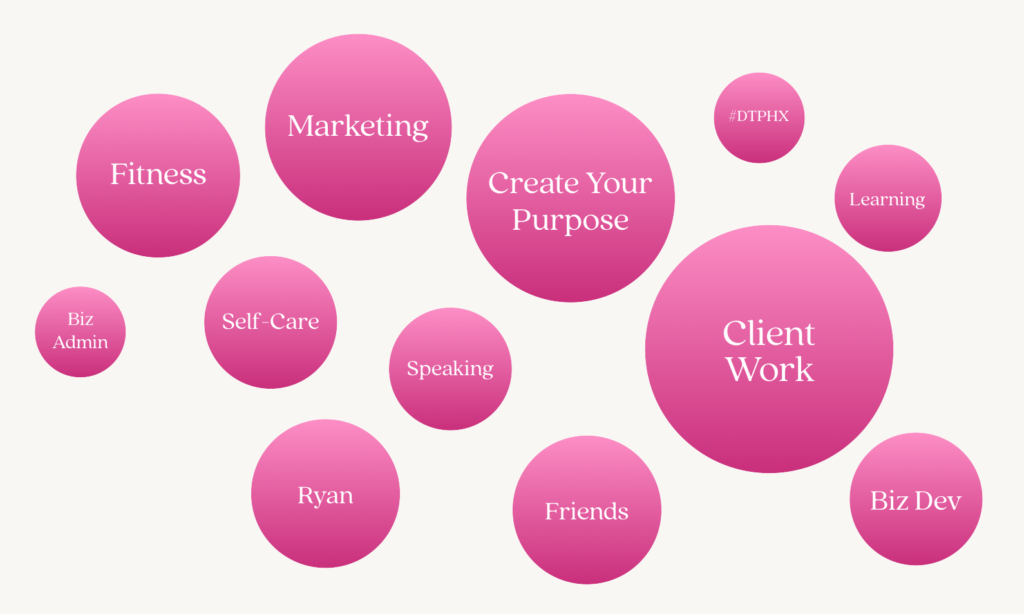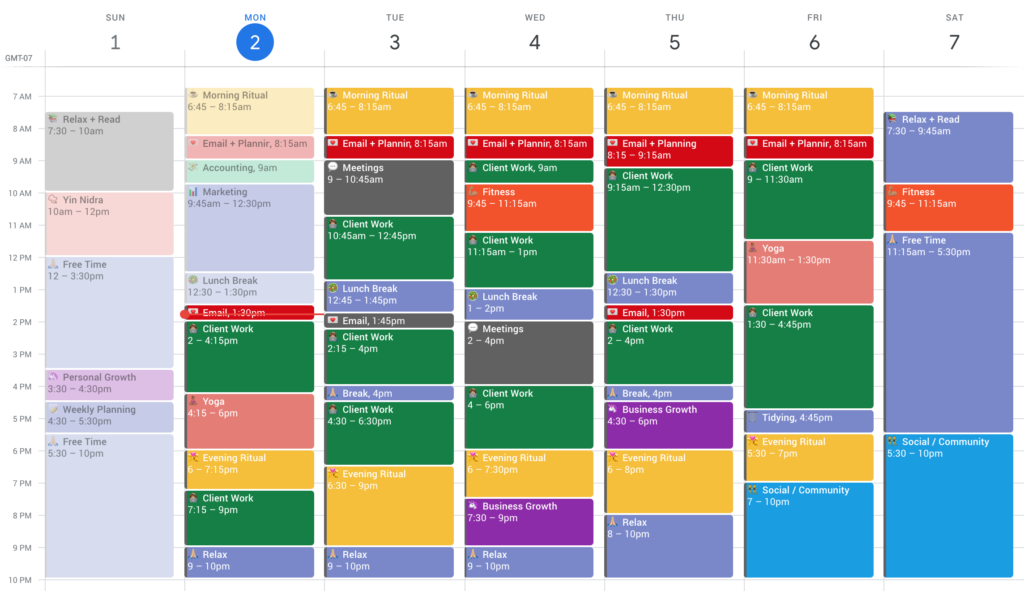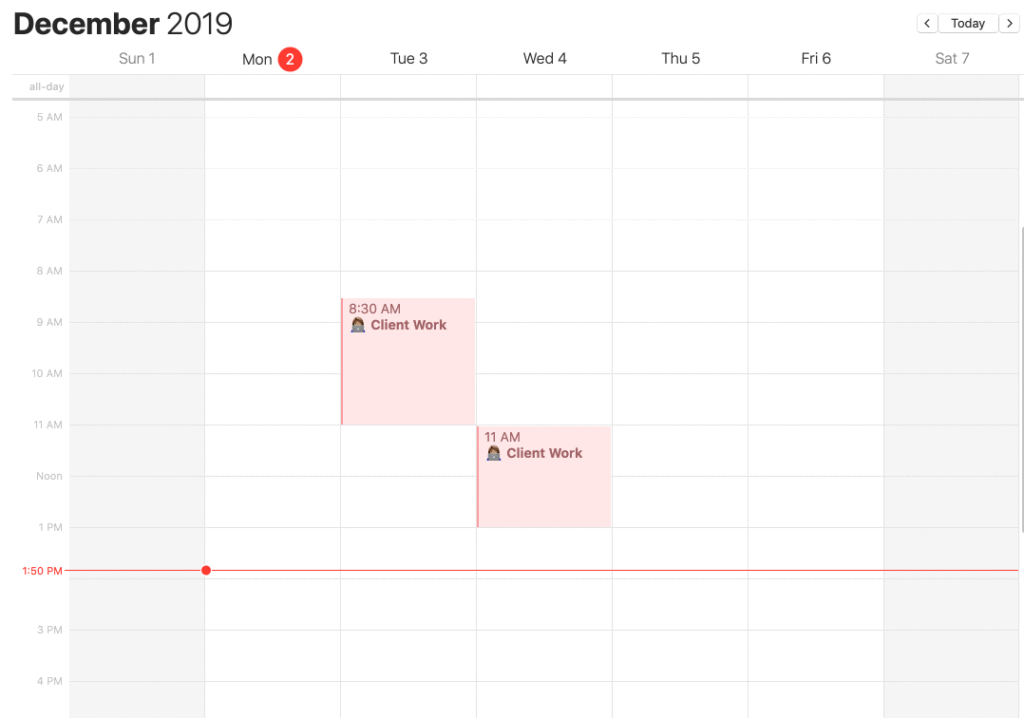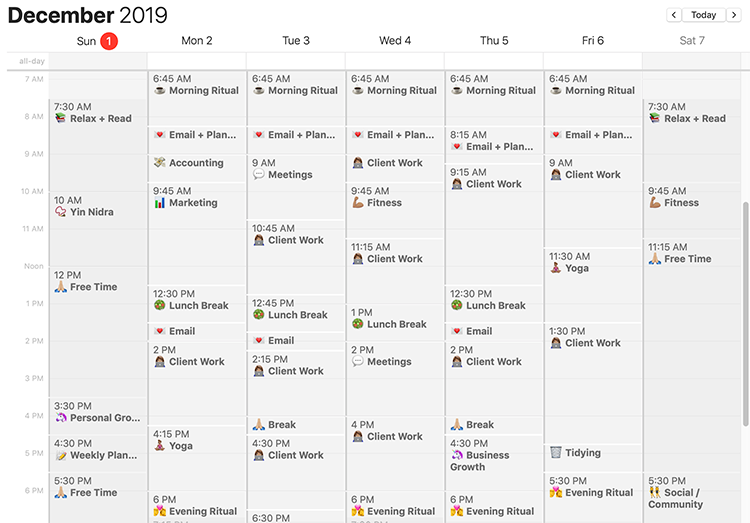How to Design Your Ideal Week Blueprint to Regain Time & A Sense of Purpose
It's time to get clear on your priorities. In this post, I lay out why I think every entrepreneur should map their ideal week in order to do better, more meaningful work.

Have you ever sat down to think about what your ideal week would be like?
Like really thought about it, not just mused “I wish I I could go to more Crossfit sessions every week” or “I don’t want to spend so much time responding to emails.”
The first step towards making a vision real is, well, to imagine it! First, you must get clear on what it is you want more of, less of, what values you want to cultivate, and how your time should align with your goals.
Designing your ideal week is a radical act in today’s culture, where people wear busy like a badge of honor and mindlessly complain about not being able to “find” time.
But, here’s the truth: we all find time for things that matter. So, the trick to shifting your mindset from finding time to MAKING it is getting clear on what your priorities are.
Most of us float through life reacting to what it throws at us. Then, we catch ourselves in a quiet moment wondering why we’re unhappy or unfulfilled. It’s often because we never have sat down to:
- Get clear on what we want and why we want it.
- Create a plan to make it happen.
- Make time to make progress.
This is the exact reason why I founded Create Your Purpose – to help people end the cycle and actually make progress towards bringing their ideas to life.
In order to do that, you must proactively manage your time and energy and make consistent progress toward your goals. I once heard a yoga teacher say this during a class, and it rings true here:
“The most important thing is knowing what the most important thing is.”
In this blog, I’ll walk you through how to uncover your most important things and do a creative, clarity-building exercise to design your ideal week blueprint.
What is an Ideal Week Blueprint?
An Ideal Week Blueprint is your guide to aligning your grand vision for your life and your work with your reality. It’s kind of like a vision board but with a calendar instead of imagery.
It is the glue that connects your overarching why – your purpose – with your small day-to-day actions, and ensures that they are helping, not hindering your larger goals.
On a more literal level, your Ideal Week Blueprint is a fully-fleshed out calendar of one singular, perfect week filled with all your commitments, passions, and activities that support your values.
It could look a little like this:
Let’s dive in!
First, Take an Inventory of your Present
The first step in designing your ideal week blueprint is to take an inventory of all that have going on currently in the form of your big life “buckets” or categories. Before you imagine an idealized future, you need to understand the present shape of things so you can make intentional decisions on what you want to begin, end, or continue.
By taking stock of your present, you may just end up being surprised at all that you have going on and what you’ve let into your life without thinking.
The first time I personally did this, I used mind mapping to create big circles for the different parts of my life – fitness, business, volunteer work, relationships, on and on. After writing it all out, I had three realizations:
- I was spread thin between competing priorities.
- One of my ‘big ideas’ didn’t fit in with or support the others.
- What I really needed was more mental space and free time.
I have continually returned to this exercise over the years to reassess my progress towards my “ideal” and reaffirm my priorities. Here is how a recent inventory looked (cleaned up to show you here since my mind maps are usually raw and only legible my me!).

I sized my circles based on how much time and energy things take, which helped me visualize how things may be resized in the future. Looking at this, I know that I want to diminish “Client Work” and increase time devoted to “Create Your Purpose.” A year ago, “DTPHX” – my local community advocacy work – took up too much time and energy and I worked to change that. Insights like this fueled my actions.
What to include in your inventory:
- Your job or business and anything big within that
- Personal commitments and relationships
- Hobbies, side hustles, and passion projects
- Health and wellness, self-care, fitness
- Future ideas and goals
The format and quantity of this survey is completely up to you. There is no need to get super granular – just focus on broad categories instead of specific activities. Also, don’t worry about “getting it right” – everyone’s inventory will be unique to them. It doesn’t need to be a mind map even, just a simple list will do.
Simply take stock of what you’ve got going on, and then assess using these prompts…
Questions to ask yourself:
- What do I want to begin that isn’t currently happening?
- What do I want to stop that isn’t serving me?
- What do I want to continue doing or expand on?
- What activities align with certain values of mine? Which don’t?
- Am I doing too much? Too little?
Your action item: In whatever format works for you, take an inventory of your present. Identify your major “buckets” in your life and how much time and energy they take. Then, simply write down 3-5 takeaways that this exercise brought up for you. Bonus: Redraw your inventory based on what you want it to look like one year from now.
How to Design your Ideal Week Blueprint
Now that you’ve built some clarity around what you’ve got going on now and what you want in your future, it’s time to get creative!
Get cozy on the couch, light a candle, maybe pour yourself a glass of wine and turn on your favorite music. Make designing your ideal blueprint fun and invigorating experience!
Step One: Decide on Your Time Blocks
Keeping in mind your values and priorities from your inventory, begin to list out your different time blocks for categories of activities. There may be some overlap with your inventory, but these should be a bit more specific to recurring activities that happen during your week. This is your chance to get creative and decide what makes sense for you.
Here’s a breakdown of mine:
? Accounting
??? Client Work
? Email + Planning
? Evening Ritual
?? Fitness
?? Free Time / Break / Relax
? Lunch Break
? Marketing
? Meetings
☕️ Morning Ritual
? Personal or Business Growth
?♀️ Social / Community
? Tidying
??♀️ Yoga
What I chose for my buckets very much reflected my goals. For example, “Tidying” had to go on my list because historically I’ve been really bad at it and it was an annoying point of conflict in my house ? Adding in “Morning Ritual” was also really important for me, because at the time of designing my Ideal Week, I did not have one and I knew I wanted to start my days slower instead of rushing right to my email.
Remember: Your time blocks will be uniquely yours, and you’re not getting graded on this. Chill, dude 🙂
Your action item: Create a simple list of the major time blocks that you must have now and that you want to have in the future.
Step Two: Pick a Calendar to Use
You’re literally going to be mapping out your blueprint on a visual calendar for one whole week. It doesn’t matter if it is on paper or on the computer; do whatever works for you.
I personally used my Apple desktop calendar (pictured earlier in this blog) since it’s easy, accessible and I could use fun emojis. This syncs from my Google Calendar, which is also a great place to do this because you can color code! See below.

Whichever tool you end up using, I recommend separating your Ideal Week calendar from your everyday actual calendar. This should be a living, breathing calendar you return to from time-to-time and you don’t want it mixing with your reality…yet.
Your action item: Decide on your calendar tool or test some out if you’re not sure what to use.
Step Three: Map Your Time Blocks to your Calendar
Now it’s time to get designing!
I recommend having a full week’s view open at a time instead of a day-by-day calendar. This will help you get a broader view of your time.
Start by adding in your time blocks to your week while asking yourself these questions:
- How often do certain activities need to happen?
- When do they happen?
- For how long?
These questions will help you be clear on the frequency, scheduling, and duration of your time blocks.
Remember, this is your ideal week and not a real schedule, so it should be less about specifics and more about getting clear on generally how much time and energy you need and want to devote to certain activities. Notice if your negative inner critic is saying these things won’t ever happen, and push it aside for now. Just dream a little, darling!

Here are some insights I personally gained:
- Yoga & Fitness: One of my goals was to ramp up my physical wellness, so I decided going to 3-4 classes a week felt like a meaningful change, yet still realistic.
- Meetings: I decided I wanted to keep my Mondays and Fridays completely free of meetings or calls, so I only scheduled them for mid-week. I ended up signing up for Calendly in order to bring this boundary to life – now, people can only book with me on those days.
- Business Growth: For years, I focused solely on helping my clients grow their businesses and found it hard to ever make time to work ‘on’ my business instead of just ‘in’ it. Knowing my priorities, I put two short blocks so I could start devoting time to it.
The end result of your calendar is completely up to you, but I do encourage you to fill it up as much as you can, and don’t forget to add unplanned free time! Those are just as important as structured time.
Digital calendar tip: Once you’re totally done, set your time blocks to repeat every week so any time you open your calendar in the future, it’s the same every week. Or just screenshot it so you can reference it later. Maybe even print it to serve as a physical reminder of your goals.
Analog calendar tip: If you’re doing this by hand, make sure you use pencil for the first round. You want to be able to change things as you’re designing it. Once you’re done, whip out those colored markers and stickers (dare I add: glitter!) and make it beautiful. Then hang it up somewhere so you can see!
Your action item: Set aside 1-2 hours to get creative and design your Ideal Week. Make it special and fun. If it helps, do a rough draft and return to it after a few days to see if any more insights have come to you since you began. Then revise and finalize!
How to Use Your Ideal Week Blueprint
Your Ideal Week Blueprint is simply a creative map to help you harness your time and energy in order to create the life and business you envision. Part of its power simply lies in forcing yourself to think about the big picture and getting clear on what it is you want. It’s not often we get a chance to do that, so soak this up!
After you complete your Ideal Week Blueprint, keep it in the back of your mind for awhile. At the end of every week, reflect on a few questions to help you see how things are aligned with your vision or not:
- What is one win I experienced this week?
- What is one challenge I’m facing?
- What do I need to bring my Ideal Week more to life?
You may want to also experiment with scheduling general blocks on your real calendar, using a strategy called time blocking. This is super similar to your Ideal Week exercise, but specific to your actual week. By doing this, you can start to align your reality with your vision and slowly make progress to bringing it to life.
My Results
I first designed my Ideal Week about two years ago, and it was an eye-opening experience for me. I had recently left a big client of mine, and had to restructure my time completely, so this exercise really helped me get clear on what I truly wanted.
What I discovered was that I needed to establish healthy boundaries for myself. I’m a solopreneur after all, so if I wasn’t going to do it, no one would.
For example, I was spending way too much time in my email inbox. It was a literal time-suck. So it was a radical step for me to take when I created set time blocks on my Ideal Week calendar.
For as long as I could remember, I left my email inbox open all of the time and used it as my to-do list, and then wondered why I felt stressed and frazzled from so many notifications. I ended up setting up a tool – Inbox Pause – to stop all incoming emails, and now I only check my email 2-3 times a day, and spend less than 20 minutes in there.
This was just one insight I gained, and I’ve shared numerous more throughout this post. I can tell you this, I’m not sure I would have made as much progress as I have toward realizing my purpose and goals without my Ideal Week Blueprint. Looking at it now, I’m amazed that likely only a year after creating it, I had made it a reality.
I made time for what was important because I knew what the most important things were. Was it easy? Hell no. But it sure was worth it.
Now, I’m working on a brand new Ideal Week Blueprint and I already know my life and business “circles” from my inventory are going to grow and diminish in size. It’s going to involve less client work, more time invested into building my community and courses, and more creative blocks to explore my writing.
I can’t wait to see what happens for you.
Liked this exercise or have questions? Leave me a comment below!
I have to credit these three articles which were my initial source of inspiration for doing this exercise myself:
- Marie Poulin – “How designing your ideal week can increase your productivity (and sanity)”
- Michael Hyatt – “How to Better Control Your Time by Designing Your Ideal Week”
- Time Zillionaire – “How to plan the week by creating your Week Map”








This is so helpful! Thanks for sharing Quinn. Do you ALWAYS do money, marketing, etc on a specific day or you just make sure you have a block for each of these in each week however it fits best into that week?
So glad you liked this, Lauren! When I first started aligning this ideal with my reality, I just made sure I had them somewhere in my week. After awhile, I found the power in assigning certain tasks for certain days, so I typically do Accounting on Mondays. Marketing is on Mondays and Fridays. Tues-Thurs are for Client Work and Meetings mostly. That doesn’t mean I don’t do the other things then if time allows, but generally, theming my days works as long as I have some flexibility built-in so I don’t feel like a robot!
Thank you so much for sharing the tips, Quinn! I once tried blocking weekly themes in my calendar and then failed to keep up, so I thought this method might not work for me. But after reading about your approach, it definitely made me want to try again but treating it as ‘a blueprint’ that I can come in to reflect my week and be more present with how I literally spend my time : )
Terri – I’m happy you liked my blog! My ideal week blueprint has been a great foundation to build upon with my weekly schedules. It’s more of a reflection exercise than anything else!